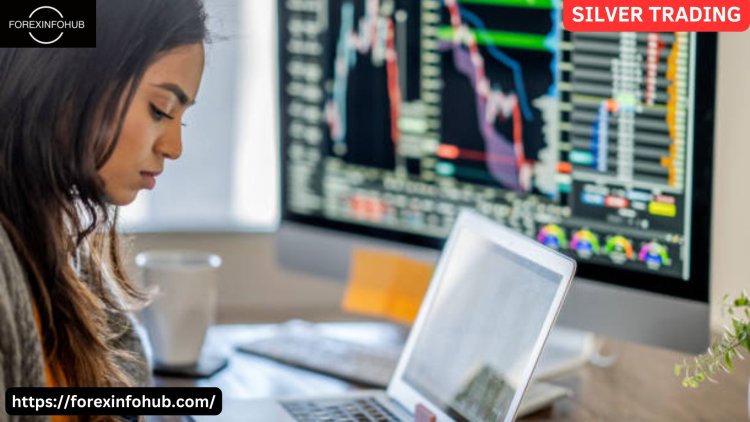Silver Trading Challenges No One Talks About—And How to Tackle Them
Uncover hidden risks of silver trading and learn actionable strategies for investing in silver effectively. Your guide to navigating silver market volatility.
Share this Post to earn Money ( Upto ₹100 per 1000 Views )

Silver trading has long been a favorite among commodity traders and retail investors looking to diversify their portfolios. Known as "the people's metal," silver appeals because of its industrial uses, relative affordability, and its reputation as a hedge against economic uncertainty. However, beneath the allure lies a complex marketplace with unique challenges that many traders overlook.
If you're investing in silver or considering jumping into this volatile, fast-moving market, it’s crucial to understand the risks. This blog will explore the hidden challenges of silver trading, why they matter, and actionable strategies to overcome them. By the end, you'll have a clear understanding of how to better approach the silver market.
Understanding the Nature of Silver Trading
Before unpacking the hidden hurdles, it’s essential to grasp a few basics about silver trading. Silver is both a commodity and an asset used in financial markets. It can be traded in several ways, including:
-
Silver Futures: Contracts where investors agree to buy or sell silver at a specific price at a future date.
-
Physical Silver: Coins, bars, or bullion held as tangible investments.
-
Silver ETFs: Funds that track the price of silver without requiring you to hold the physical asset.
-
Silver Mining Stocks: Shares in companies that mine or produce silver.
Unlike gold, silver has heavy industrial demand in sectors such as electronics, medicine, and renewable energy. This dual role as both a precious metal and an industrial commodity significantly impacts its price movements.
However, silver trading isn’t just about picking the right strategy or form of investment. It comes with inherent risks and challenges that require careful consideration.
Hidden Challenges in Silver Trading
1. High Market Volatility
Silver is notorious for experiencing intense price swings, often more dramatic than gold. Because it has a much smaller market compared to other traded assets, such as gold or crude oil, silver prices react strongly to even small shifts in demand or supply.
Example: Between 2010 and 2011, silver surged from $18 to $49 per ounce. But by mid-2013, it dropped below $20, highlighting how quickly gains can evaporate.
Why it matters: This volatility can double the potential for profits, but it equally increases the risk of significant losses. Retail investors who aren’t prepared for these sharp fluctuations may make rash decisions, selling too early or holding during deeper declines.
2. Illiquidity in Certain Market Conditions
Unlike gold, which boasts high trading volumes and constant liquidity, silver markets can suffer from illiquidity. This is particularly true in times of low trading activity or during periods of extreme market stress.
Example: During economic slowdowns, the industrial demand for silver tends to fall, which can lead to wider bid-ask spreads on contracts and lower trading volumes.
Why it matters: Illiquidity makes it harder to execute trades at desired prices, leading to higher transaction costs and limiting your ability to respond quickly to price movements.
3. Storage and Security Costs for Physical Silver
For those who prefer the tangible appeal of silver bullion or coins, storage can be a real challenge. Silver is far bulkier than gold in terms of value-for-weight, meaning even moderate investments require a significant amount of storage space.
Why it matters: Proper storage needs to safeguard against theft, environmental damage, and wear. Safe options, like bank vaults or secure storage facilities, usually come with recurring fees, eating into your profits.
4. Complex Pricing Dynamics
One of the most misunderstood aspects of silver is how its price is determined. Silver’s hybrid identity as both a precious metal and an industrial commodity means its price responds to two distinct factors:
-
Precious Metal Drivers: Inflation rates, geopolitical tensions, central bank policies.
-
Industrial Drivers: Advances in solar energy or electronics, shifts in manufacturing demand.
Why it matters: These dual dynamics result in unpredictable price behavior, and retail investors may find it difficult to analyze and predict silver trading risks accurately.
5. Influence of Speculation
Silver markets are often subject to speculative activity driven by retail traders and institutional investors. This is particularly true during periods of economic uncertainty or broader market hype.
Example: The 2021 silver "short squeeze" movement, fueled by Reddit forums, caused a temporary spike in silver prices. However, prices corrected quickly, leading to significant losses for latecomers.
Why it matters: Speculative surges can create short-term opportunities, but they also distort market fundamentals. Relying on speculative trends without a solid strategy can result in poor decision-making and financial losses.
Strategies to Tackle Silver Trading Challenges
Now that we’ve discussed the risks, how can you prepare to face these challenges? Here are some practical strategies:
Manage Market Volatility with Diversification
To minimize the impact of silver’s price swings, avoid putting all your capital in one type of silver investment. Diversifying within commodities (e.g., pairing silver with gold) or across assets (e.g., stocks, ETFs, or bonds) reduces risk.
Choose the Right Trading Instrument
Each silver trading method has its pros and cons. For example:
-
Invest in silver ETFs if you want exposure without the hassle of storage.
-
Use futures for short-term speculative opportunities.
-
Favor physical silver if you’re seeking a long-term hedge against inflation.
Make sure your choice aligns with your risk tolerance and financial goals.
Stay Updated on Industry Demand
Stay informed about developments in industries that impact silver’s industrial demand, such as renewable energy or electronics. Understanding these factors will help you predict price movements and time your trades effectively.
Adopt a Long-Term Perspective
If you’re investing in silver for wealth preservation or portfolio diversification, try to look beyond short-term fluctuations. Historically, silver has retained its intrinsic value, even amid turbulent times.
Leverage Risk Management Tools
If you’re engaging in active trading, consider implementing stop-loss or take-profit orders to protect yourself from downside risk and lock in gains during favorable movements.
Align with Trusted Brokers or Advisors
Navigating silver trading on your own can be overwhelming. Working with a trusted brokerage or investing platform ensures access to up-to-date data, trading tools, and professional insights.
Focus on Education
Stay informed about silver market volatility and risks by leveraging credible resources, expert opinions, and financial analysis. Platforms like Investopedia or commodity-specific podcasts can be excellent sources of continuous learning.
Final Thoughts: Turn Risks Into Opportunities
While silver trading comes with its fair share of risks, it also presents unique opportunities for those who take the time to understand its nuances. From combating market volatility with diversification to leveraging AI-driven trading tools for better decision-making, investing in silver doesn’t need to feel overwhelming.
Remember, preparation and education are your strongest allies. If you’re ready to explore silver trading while minimizing risks, start by applying these insights step by step.
For more tips and resources on trading, be sure to bookmark our blog or subscribe to our newsletter. Knowledge is your greatest weapon in turning challenges into successes.
















